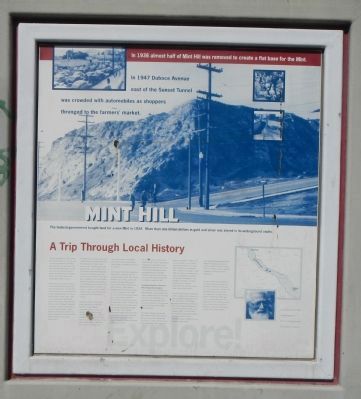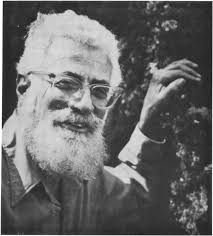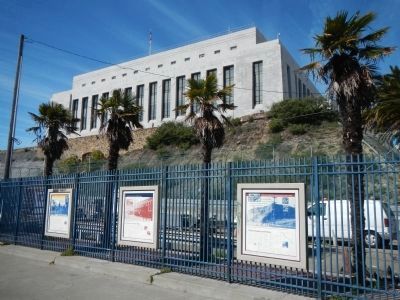Duboce Triangle in San Francisco City and County, California — The American West (Pacific Coastal)
Mint Hill
A Trip Through Local History
— Clyde Wahrhaftig —
In 1936 almost half of Mint Hill was removed to create a flat base for the Mint.
In 1947 Duboce Avenue east of the Sunset Tunnel was crowded with automobiles as shoppers thronged to the farmers’ market.
The area near Market and Church Streets was an Ohlone village site. This was near a stream that flowed from Twin Peaks, along 14th Street to Church Street, 15th Street and into Dolores Lagoon. To this day, heavy rains sometime flood the intersection of 14th, Church, and Market Streets. In the 1870s and ’80s many Scandinavians settled in the area.
Market Street was extended southwest by excavating what is now Mint Hill to the north of this site. This serpentine belt extends diagonally through San Francisco from Fort Point to Hunter’s Point. Street cuts also destroyed the Market Street Reservoir near this site, leaving Reservoir Street (now part of Safeway’s parking lot) as a legacy. This low area was known as San Souci (Carefree) Valley. Duboce Avenue was named after Colonel Victor Duboce, commander of the First California Volunteer Regiment in the Spanish American War.
In 1928 the Sunset Streetcar Tunnel west of Noe Street was built under Buena Vista Hill, making Duboce Avenue a major transit corridor. The federal government bought land for a new U.S. Mint in 1934. In 1936 almost half of Mint Hill (originally ninety feet above Duboce Avenue) was removed to create a flat base for the Mint. Upon completion in 1937, this one million dollar Art Deco building was described by a local newspaper as the “strongest, most quake-proof, burglarproof building in San Francisco.” However, the day it opened several teenagers armed with cap pistols scaled its walls and climbed through a window.
Between the windows in the exterior granite clad walls are 44 three-foot diameter concrete medallions representing historic U.S. coins. The Hermann Street lobby glitters with polished marble and bronze. Below it, underground vaults blasted out of solid rock once contained more than one billion dollars of gold and silver.
The Mint no longer produces circulating coins. It now makes medals and ‘collectable coins’ (special coins to commemorate events, people, or institutions important to U.S. History).
San Francisco’s first farmers’ market was established on a vacant lot where the Safeway parking lot stands today. During World War II gas rationing, people could not drive to the farms to buy surplus crops. So the farmers decided to come to the consumers. Mint employees applauded when the farmers first arrived at 6:30 a.m. August 12, 1943. Within three days, fifty thousand people shopped there. Twenty farmers raised three thousand dollars to build sheds and gave them to the city as a gift. In 1944 the city took over ownership of the market, which by its second year recorded four million dollars in sales. Voters approved continuing the market by more than five-to-one margin in 1945. They later voted to acquire the permanent Alemany Boulevard site, where the present market reopened in 1947.
This site forms the east corner of the Duboce Triangle, formerly called Gaffney’s Triangle after a local politician. More people began to move here in the 1970s as the new Muni Metro light rail tunnel shortened travel time to downtown. Among the newcomers were many gay men, who made up about 50 percent of the Triangle’s residents by 1980.
This is a fitting site to commemorate Dr. Clyde Wahrhaftig, a noted geologist who lived in a cottage perched on a Noe Valley chert outcrop. Dr. Wahrhaftig was a Professor Emeritus of Geology at the University of California. He was a member of the U.S. Geological Survey staff for more than 50 years.
Described by colleagues as one of the most colorful members of his profession, this Fresno native was a lifelong public transit user. He chose not to learn how to drive an automobile. When questioned about this, he replied, “In college I was too poor to afford a car, and when I worked in Alaska there were
no roads. When I returned to live in California in 1850, I realized the advantages to health, safety, and sanity in not knowing how to drive, and managed to get around on foot and public transportation, or by sponging on my friends.” He did his research on foot or by public transportation as was professionally active in environmental matters.
One of his favorite pastimes was guiding others to geologic points of interest. He wrote “A Streetcar to Subduction – and Other Plate Tectonic Trips by Public Transport in San Francisco,” “A Walker’s Guide to the Geology of San Francisco,” and “The Hayward Fault in Hayward and Fremont via BART.” This site, with its green serpentine visible below the Mint, is the starting point of one of Dr. Wahrhaftig’s geological explorations of San Francisco by public transit.
Upon receiving the Distinguished Career Award from the Geological Society of America in 1989, he came out as a gay man in his acceptance speech, urging his colleagues to accept gay students without bias.
The Duboce Avenue project was funded by a Transport Enhancement Activities (TEA) grant through the Metropolitan Transportation Commission. Special thanks to John Katz of the Municipal Railway and to volunteer graphic artists Fabienne David, John Eagle, and Ann Pisabell. ‘The Golden Gate’s Golden Age of Cycling’ was written by Mary Brown, ‘A Trip Through Local History’ by Pete Tasmen, and ‘San Francisco Streetcar History’ by Allison Cant. Photographs courtesy of the SF Public Library’s SF History Center and Dorothy Lindheim.
Erected by Metropolitan Transportation Commission.
Topics and series. This historical marker is listed in this topic list: Landmarks. In addition, it is included in the Art Deco series list.
Location. 37° 46.173′ N, 122° 25.628′ W. Marker is in San Francisco, California, in San Francisco City and County. It is in Duboce Triangle. Marker is on Duboce Avenue near Market Street, on the right when traveling west. Touch for map. Marker is at or near this postal address: 316 Duboce Avenue, San Francisco CA 94114, United States of America. Touch for directions.
Other nearby markers. At least 8 other markers are within walking distance of this marker. King of the Road! (a few steps from this marker); The Industrial Age (a few steps from this marker); California Volunteers' Memorial (about 300 feet away, measured in a direct line); St. Francis Lutheran Church (about 700 feet away); Haight-Fillmore Building (approx. ¼ mile away); Swedish American Hall (approx. ¼ mile away); Elixir (approx. 0.4 miles away); Watershed History (approx. 0.4 miles away). Touch for a list and map of all markers in San Francisco.
More about this marker. This portion of Duboce Avenue is a bikeway.
Marker appears to have suffered bullet strikes.
Also see . . .
1. San Francisco Mint - Wikipedia. Wikipedia entry:
The new Mint was opened in 1937. Beginning in 1955, circulating coinage from San Francisco was suspended for 13 years. In 1968, it took over most proof coinage production from the Philadelphia Mint, but continued striking a supplemental circulating coinage from 1968 through 1974. Since 1975, the San Francisco Mint has been used only for proof coinage, with the exception of the Susan B. Anthony dollar from 1979–81 and a portion of the mintage of cents in the early 1980s. (Submitted on March 30, 2014, by Barry Swackhamer of Brentwood, California.)
2. Clyde Wahrhaftig. Wikipedia entry:
Wahrhaftig was a Renaissance man, with a rich store of knowledge and love of literature, music and art, of history and philosophy. He had a profound human caring about the condition of his fellow man and society, and he gave active expression to that care in his professional, personal and political life. He was one of the more colorful characters of his profession; his personal idiosyncrasies gave rise to stories and anecdotes that friends cherish over a glass of wine or scotch. (Submitted on March 12, 2023, by Larry Gertner of New York, New York.)
Credits. This page was last revised on March 12, 2023. It was originally submitted on March 30, 2014, by Barry Swackhamer of Brentwood, California. This page has been viewed 577 times since then and 32 times this year. Last updated on January 17, 2019, by Mike Hunt of San Francisco, California. Photos: 1. submitted on March 30, 2014, by Barry Swackhamer of Brentwood, California. 2. submitted on March 12, 2023, by Larry Gertner of New York, New York. 3. submitted on March 30, 2014, by Barry Swackhamer of Brentwood, California.


